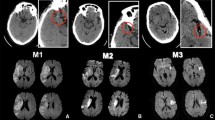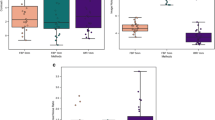Abstract
Purpose
To determine the optimal slice thickness of brain non-contrast computed tomography using a hybrid iterative reconstruction algorithm to identify hyperdense middle cerebral artery sign in patients with acute ischemic stroke.
Methods
We retrospectively enrolled 30 patients who had presented hyperdense middle cerebral artery sign and 30 patients who showed no acute ischemic change in acute magnetic resonance imaging. Reformatted axial images at an angle of the orbitomeatal line in slice thicknesses of 0.5, 1, 3, 5, and 7 mm were generated. Optimal slice thickness for identifying hyperdense middle cerebral artery sign was evaluated by a receiver operating characteristics curve analysis and area under the curve (AUC).
Results
The mean AUC value of 0.5-mm slice (0.921; 95% confidence interval (95% CI), 0.868 to 0.975) was significantly higher than those of 3-mm (0.791; 95% CI, 0.686 to 0.895; p = 0.041), 5-mm (0.691; 95% CI, 0.583 to 0.799, p < 0.001), and 7-mm (0.695; 95% CI, 0.593 to 0.797, p < 0.001) slices, whereas it was equivalent to that of 1-mm slice (0.901; 95% CI, 0.837 to 0.965, p = 0.751).
Conclusion
Thin slice thickness of ≤ 1 mm has a better diagnostic performance for identifying hyperdense artery sign on brain non-contrast computed tomography with a hybrid iterative reconstruction algorithm in patients with acute ischemic stroke.



Similar content being viewed by others
References
Gács G, Fox AJ, Barnett HJ, Vinuela F (1983) CT visualization of intracranial arterial thromboembolism. Stroke 14:756–762. https://doi.org/10.1161/01.STR.14.5.756
Pressman BD, Tourje EJ, Thompson JR (1987) An early CT sign of ischemic infarction: increased density in a cerebral artery. Am J Roentgenol 149:583–586. https://doi.org/10.2214/ajr.149.3.583
Lombardi S, Riva L, Patassini M, Remida P, Capraro C, Canonico F, Franzesi CT, Ippolito D (2018) “Hyperdense artery sign” in early ischemic stroke: diagnostic value of model-based reconstruction approach in comparison with standard hybrid iterative reconstruction algorithm. Neuroradiology 60:1273–1280. https://doi.org/10.1007/s00234-018-2092-3
Jensen-Kondering U (2010) Hyperdense artery sign on computed tomography in acute ischemic stroke. World J Radiol 2:354–357. https://doi.org/10.4329/wjr.v2.i9.354
Mair G, Boyd EV, Chappell FM, von Kummer R, Lindley RI, Sandercock P, Wardlaw JM, IST-3 Collaborative Group (2015) Sensitivity and specificity of the hyperdense artery sign for arterial obstruction in acute ischemic stroke. Stroke 46:102–107. https://doi.org/10.1161/STROKEAHA.114.007036
Eung YK, Lee SK, Dong JK et al (2005) Detection of thrombus in acute ischemic stroke: value of thin-section noncontrast-computed tomography. Stroke 36:2745–2747. https://doi.org/10.1161/01.STR.0000185720.03803.41
Riedel CH, Jensen U, Rohr A, Tietke M, Alfke K, Ulmer S, Jansen O (2010) Assessment of thrombus in acute middle cerebral artery occlusion using thin-slice nonenhanced computed tomography reconstructions. Stroke 41:1659–1664. https://doi.org/10.1161/STROKEAHA.110.580662
Pontana F, Duhamel A, Pagniez J, Flohr T, Faivre JB, Hachulla AL, Remy J, Remy-Jardin M (2011) Chest computed tomography using iterative reconstruction vs filtered back projection (part 2): image quality of low-dose CT examinations in 80 patients. Eur Radiol 21:636–643. https://doi.org/10.1007/s00330-010-1991-4
Yamada Y, Jinzaki M, Hosokawa T, Tanami Y, Sugiura H, Abe T, Kuribayashi S (2012) Dose reduction in chest CT: comparison of the adaptive iterative dose reduction 3D, adaptive iterative dose reduction, and filtered back projection reconstruction techniques. Eur J Radiol 81:4185–4195. https://doi.org/10.1016/j.ejrad.2012.07.013
Chen CM, Lin YY, Hsu MY, Hung CF, Liao YL, Tsai HY (2016) Performance of adaptive iterative dose reduction 3D integrated with automatic tube current modulation in radiation dose and image noise reduction compared with filtered-back projection for 80-kVp abdominal CT: anthropomorphic phantom and patient study. Eur J Radiol 85:1666–1672. https://doi.org/10.1016/j.ejrad.2016.07.002
Nakaura T, Iyama Y, Kidoh M, Yokoyama K, Oda S, Tokuyasu S, Harada K, Yamashita Y (2016) Comparison of iterative model, hybrid iterative, and filtered back projection reconstruction techniques in low-dose brain CT: impact of thin-slice imaging. Neuroradiology 58:245–251. https://doi.org/10.1007/s00234-015-1631-4
Maamoun I, Khalil MM (2018) Assessment of iterative image reconstruction on kidney and liver donors: potential role of adaptive iterative dose reduction 3D (AIDR 3D) technology. Eur J Radiol 109:124–129. https://doi.org/10.1016/j.ejrad.2018.10.020
Hamamura T, Hayashida Y, Takeshita Y, Sugimoto K, Ueda I, Futatsuya K, Kakeda S, Aoki T, Korogi Y (2019) The usefulness of full-iterative reconstruction algorithm for the visualization of cystic artery on CT angiography. Jpn J Radiol 37:526–533. https://doi.org/10.1007/s11604-019-00839-x
Iyama Y, Nakaura T, Oda S, Kidoh M, Utsunomiya D, Yoshida M, Yuki H, Hirata K, Funama Y, Harada K, Awai K, Hirai T, Yamashita Y (2017) Iterative reconstruction designed for brain CT: a correlative study with filtered back projection for the diagnosis of acute ischemic stroke. J Comput Assist Tomogr 41:884–890. https://doi.org/10.1097/RCT.0000000000000626
Inoue T, Nakaura T, Yoshida M, Yokoyama K, Uetani H, Oda S, Utsunomiya D, Kitajima M, Harada K, Yamashita Y (2018) Brain computed tomography using iterative reconstruction to diagnose acute middle cerebral artery stroke: usefulness in combination of narrow window setting and thin slice reconstruction. Neuroradiology 60:373–379. https://doi.org/10.1007/s00234-018-1982-8
Liu X, Chen L, Qi W, Jiang Y, Liu Y, Zhang M, Hong N (2017) Thin-slice brain CT with iterative model reconstruction algorithm for small lacunar lesions detection: image quality and diagnostic accuracy evaluation. Medicine 96:e9412. https://doi.org/10.1097/MD.0000000000009412
Smith BJ, Hillis SL, Pesce LL (2020) _MCMCaov: multi-reader multi-case analysis of variance_. R package version 0.1.10, <URL: https://github.com/brian-j-smith/MRMCaov>. Accessed 27 July 2020
Smith BJ, Hillis SL (2020) Multi-reader multi-case analysis of variance software for diagnostic performance comparison of imaging modalities. In Samuelson F, Taylor-Phillips S (eds.), _Proceedings of SPIE 11316, Medical imaging 2020: image perception, observer performance, and technology assessment_, 113160K. doi: 10.117/12.2549075 (URL: 10.117/12.2549075),<URL:https://pubmed.ncbi.nlm.nih.gov/32351258>
Chrzan R, Gleń A, Urbanik A (2017) Hyperdense middle cerebral artery sign as the only radiological manifestation of hyperacute ischemic stroke in computed tomography. Neurol Neurochir Pol 51:33–37. https://doi.org/10.1016/j.pjnns.2016.10.003
Riedel CH, Zoubie J, Ulmer S, Gierthmuehlen J, Jansen O (2012) Thin-slice reconstructions of nonenhanced CT images allow for detection of thrombus in acute stroke. Stroke 43:2319–2323. https://doi.org/10.1161/STROKEAHA.112.649921
Kanal KM, Stewart BK, Kolokythas O, Shuman WP (2007) Impact of operator-selected image noise index and reconstruction slice thickness on patient radiation dose in 64-MDCT. Am J Roentgenol 189:219–225. https://doi.org/10.2214/AJR.06.1524
Ernst M, Romero JM, Buhk JH, Kemmling A, Fiehler J, Groth M (2014) Sensitivity of visual and quantitative detection of middle cerebral artery occlusion on non-contrast-enhanced computed tomography. Neuroradiology 56:1063–1068. https://doi.org/10.1007/s00234-014-1443-y
Krings T, Noelchen D, Mull M, Willmes K, Meister IG, Reinacher P, Toepper R, Thron AK (2006) The hyperdense posterior cerebral artery sign: a computed tomography marker of acute ischemia in the posterior cerebral artery territory. Stroke 37:399–403. https://doi.org/10.1161/01.STR.0000199062.09010.77
Goldmakher GV, Camargo ECS, Furie KL, Singhal AB, Roccatagliata L, Halpern EF, Chou MJ, Biagini T, Smith WS, Harris GJ, Dillon WP, Gonzalez RG, Koroshetz WJ, Lev MH (2009) Hyperdense basilar artery sign on unenhanced CT predicts thrombus and outcome in acute posterior circulation stroke. Stroke 40:134–139. https://doi.org/10.1161/STROKEAHA.108.516690
Acknowledgments
We thank Shun Hayasaka (Sapporo Medical University Hospital) for assistance with statistical analysis and Miho Kobayashi (Kurashiki Central Hospital) for her extensive proofreading.
Author information
Authors and Affiliations
Contributions
All authors contributed to the study conception and design. Material preparation, data collection, and analysis were performed by Shota Ichikawa, Misaki Hamada, Daiki Watanabe, Osamu Ito, Takafumi Moriya, and Hiroyuki Yamamoto. The first draft of the manuscript was written by Shota Ichikawa, and all authors commented on previous versions of the manuscript. All authors read and approved the final manuscript.
Corresponding author
Ethics declarations
Conflict of interest
The authors declare that they have no conflict of interest.
Ethics approval
All procedures performed in studies involving human participants were in accordance with the ethical standards of the institutional and/or national research committee and with the 1964 Helsinki declaration and its later amendments or comparable ethical standards. This study was approved by the hospital ethics committee.
Consent to participate
For this type of study, requirement for individual informed consent was waived by the local ethics committee.
Additional information
Publisher’s note
Springer Nature remains neutral with regard to jurisdictional claims in published maps and institutional affiliations.
Rights and permissions
About this article
Cite this article
Ichikawa, S., Hamada, M., Watanabe, D. et al. Optimal slice thickness of brain computed tomography using a hybrid iterative reconstruction algorithm for identifying hyperdense middle cerebral artery sign of acute ischemic stroke. Emerg Radiol 28, 309–315 (2021). https://doi.org/10.1007/s10140-020-01864-4
Received:
Accepted:
Published:
Issue Date:
DOI: https://doi.org/10.1007/s10140-020-01864-4




